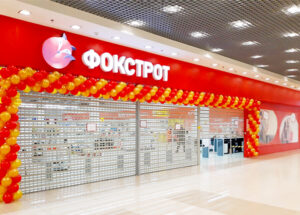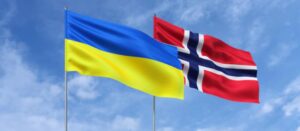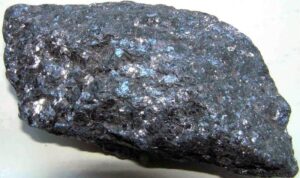
Omnichannel tech retailer Foxtrot has purchased and installed backup power supply equipment worth a total of UAH 5.565 million to ensure uninterrupted operation during 2022-2025. As of October, all stores in the chain are energy independent, the company’s press service told Interfax-Ukraine.
“For Foxtrot, investing in energy independence is a necessary step for the company’s operation and development in the context of full-scale war. This makes it possible to organize the full operation of all services and also fulfills the company’s social mission: to be a local ”point of resilience“ for Ukrainians in difficult times,” the press service noted.
During September-October 2025, Foxtrot conducted an audit of its existing resources in case of repeated blackouts: 36 stores in the chain are equipped with generators; 48 were equipped with various types of uninterruptible power supplies; 44 stores were connected to the backup power supply equipment of landlords in shopping centers/malls. All stores are equipped with powerful charging stations, UPS equipment, additional lighting powered by power banks, etc. This allows cash registers and security systems to be activated and provides sufficient lighting for service.
In September and October, one additional backup generator and six charging stations were purchased.
Thanks to innovations in IT infrastructure implemented in 2023-2024, all of Foxtrot’s core business processes — from placing an order on the website to delivering goods in stores — run on reliable digital platforms and remain stable even in the event of a power outage.
A key element in ensuring the operation of stores is the internal ecosystem and the FoxyHUB mobile application, which allows salespeople to advise customers, process purchases, and accept card payments anywhere in the store or even outside it. For convenience, various digital payment methods are available that do not depend on stationary cash registers or POS terminals: via the seller’s mobile app, LiqPay, QR code, or chatbot in Viber/Telegram. The buyer receives a fiscal receipt immediately in electronic form. In October, Foxtrot is launching tap to phone, which will allow sellers to accept card payments via the customer’s smartphone through the app.
In addition, during power outages, stores offer gadget charging stations and free Wi-Fi.
Foxtrot is one of Ukraine’s largest omnichannel retail chains in terms of the number of stores and sales of electronics and household appliances. As of early October 2025, the company operates 127 stores in 68 cities, the Foxtrot.ua online platform, and the mobile app of the same name.
According to YouControl, the revenue of FTD-Retail LLC (Kyiv), which develops the chain, amounted to UAH 14 billion 882.632 million in 2024, which is 17.6% more than in 2023, and its net profit was UAH 6 million 721 thousand against UAH 314 million 436 thousand, respectively.
The founders of the omnichannel retailer Foxtrot are Ukrainian businessmen Gennady Vykhodtsev and Valery Makovetsky.

Norway plans to allocate NOK 2 billion in 2026 to finance a new package of military equipment from the US for Ukraine as part of the PURL initiative, according to the Norwegian government’s press service.
“Ukraine depends on continued military and civilian support in its struggle to defend itself against Russia. It is of great importance that several countries are coming together to provide funding to help meet Ukraine’s military needs. Norway is now joining forces with a number of other European countries to finance a military support package that will provide high-priority defense equipment for Ukraine. We are committed to providing NOK 2 billion for the package, which is being coordinated by NATO,” said Prime Minister Jonas Gahr Støre.
The contact group meeting will take place ahead of the NATO defense ministers’ meeting on October 15. Several European countries are expected to coordinate their planned contributions to Ukraine, including support provided under the new Ukraine Requirements List (PURL) initiative. Norway has also contributed 1.5 billion Norwegian kroner to finance the previous support package under the PURL initiative.
“It is important that European countries stand together and continue to provide support so that together we can finance the delivery of military equipment needed by Ukraine, such as drones, artillery, and advanced air defense systems. Under the PURL mechanism, the US provides NATO with lists of available weapons and military equipment. Allies, including Norway, then contribute to financing the purchase of this equipment for Ukraine,” said Defense Minister Tor Sandvik.
NATO coordinates shipments to ensure that weapons arrive in Ukraine as quickly as possible. For security reasons, the specific contents of each package are not disclosed.
“Norway has now contributed to the financing of two such support packages, and the government will work to ensure that as many allied countries as possible participate in this important initiative to support Ukraine. The equipment arrives quickly and helps
Ukrainians defend the front line and protect critical infrastructure more effectively. Supporting Ukraine’s fight for freedom is not only important for Ukraine’s defense; it is also crucial for the defense of Norwegian and European security,” Sandvik emphasized.

The draft law “On the Use of Assisted Reproductive Technologies” (No. 13638) could radically change the provision of medical services in the field of reproductive technologies and lead to Ukraine losing its status as the “reproductive hub of Europe.” It requires significant revision with the involvement of the professional expert community, according to experts surveyed by Interfax-Ukraine.
“According to various estimates, up to 40-60% of patients in large reproductive medicine clinics are foreigners (especially from the EU, the UK, the US, Canada, Israel, and China). If the law does not provide for transparent mechanisms for foreign patients, such as official medical visas or agreements between countries, Ukraine may lose its status as the “reproductive hub of Europe,” said Dmytro Biletsky, head of the assisted reproductive technology department at the Adonis Medical Gynecological Center (MGK) Adonis Medical Gynecological Center (MGK).
According to him, Ukraine is currently among the top 10 global destinations for reproductive technologies, thanks in particular to “affordable prices: an IVF cycle in Ukraine costs three to five times less than in most EU countries or the US,” the high level of specialists and technologies, the certification of many clinics according to international standards, and the fact that “Ukrainian legislation allows virtually all ART methods — donor eggs, sperm, embryos, IVF programs for married couples and single women.”
“In Ukraine, anonymous donation and the creation of embryos for storage are permitted, which is not acceptable everywhere,” he said.
Predicting the impact of the bill if it is passed, Biletsky expects that in the short term (one to two years), Ukraine may lose some of its patients for reproductive technology (ART) programs, although overall demand will remain high because IVF, donation, and embryo banking procedures will remain permitted, and Ukrainian clinics have an internationally recognized reputation and competitive prices.
However, he predicts that in the medium term (three to five years), “if the rules for foreigners remain strict (especially regarding embryo transportation, donation, and surrogacy), demand will decrease by 20-40%.”
At the same time, commenting on the impact of the bill’s proposed ban on embryo donation on the development of reproductive prospects in general, Biletsky noted that “the ban on embryo donation will result in some patients simply losing the opportunity to treat infertility, as well as an increase in the number of ‘unused’ embryos in clinics.”
“Currently, some couples voluntarily give their frozen embryos to others. If this is banned, embryos will either have to be stored (which is expensive) or destroyed. This raises the ethical question: ‘What to do with embryos that could give life?’” he said.
According to his estimates, donor embryo programs may account for up to 10-15% of all IVF procedures, so clinics specializing in “full cycles” (creation, donation, surrogacy) will lose a significant share of their clients.
“Many foreign patients came specifically for donor embryo programs — this was a unique Ukrainian advantage, because in many countries (for example, Germany and Italy) this is prohibited. The ban will mean the loss of one of the key areas of reproductive medicine. Ukraine is effectively losing one of the most humane mechanisms for helping infertile couples,“ he said.
For her part, Svitlana Shiyanova, head of assisted reproductive technologies at the Dobrobut medical network, also predicts that ”the adoption of this bill will lead to a sharp decline in international demand, as it contains two critical restrictive provisions: a ban on surrogacy services if one of the spouses is a citizen of a country where this method is prohibited, and a requirement that one of the spouses be a citizen of Ukraine (for surrogacy).”
“These provisions effectively close the international surrogacy market, which has brought significant investment to the medical sector. A sharp drop in international demand is expected,” she said.
In addition, Shiyanova noted that the ban on embryo donation provided for in the bill “is one of the most restrictive and controversial provisions of the bill,” which, also contradicts the principles of evidence-based medicine (European Society of Human Reproduction and Embryology, ESHRE) and takes away the last chance for the most vulnerable category of patients, forcing them to seek this service abroad.
“For clinics, this means excluding an important service from the list, which limits the ability to provide a full range of ART and comprehensive patient care,” she said.
According to Shiyanova, the following aspects of reproductive medicine currently require regulatory regulation: the definition of infertility, the determination of who is eligible for ART, the need to ensure the anonymity of donations, the regulation of compensation, as well as the lack of a clear mechanism for creating a single national ART registry and standardized performance monitoring.
As reported, representatives of the Ukrainian Association of Reproductive Medicine (UARM) believe that government bill No. 13683 “On the Use of Assisted Reproductive Technologies” will limit Ukrainians’ access to such technologies.
Tags: Government bill on reproductive technologies may lead to Ukraine losing its status as “Europe’s reproductive hub” – experts
The draft law “On the Use of Assisted Reproductive Technologies” (No. 13638) could radically change the provision of medical services in reproductive technologies and lead to Ukraine losing its status as the “reproductive hub of Europe,” It requires significant revision with the involvement of the professional expert community, according to experts surveyed by Interfax-Ukraine.
“According to various estimates, up to 40-60% of patients in large reproductive medicine clinics are foreigners (especially from the EU, the UK, the US, Canada, Israel, and China). If the law does not provide for transparent mechanisms for foreign patients, such as official medical visas or agreements between countries, Ukraine may lose its status as the “reproductive hub of Europe,” said Dmytro Biletsky, head of the assisted reproductive technology department at the Adonis Medical Gynecological Center (MGK) Adonis Medical Gynecological Center (MGK).
According to him, Ukraine is currently among the top 10 global destinations for reproductive technologies, thanks in particular to “affordable prices: an IVF cycle in Ukraine costs three to five times less than in most EU countries or the US,” the high level of specialists and technologies, the certification of many clinics according to international standards, and the fact that “Ukrainian legislation allows virtually all ART methods — donor eggs, sperm, embryos, IVF programs for married couples and single women.”
“In Ukraine, anonymous donation and the creation of embryos for storage are permitted, which is not acceptable everywhere,” he said.
Predicting the impact of the bill if it is passed, Biletsky expects that in the short term (one to two years), Ukraine may lose some of its patients for reproductive technology (ART) programs, although overall demand will remain high because IVF, donation, and embryo banking procedures will remain permitted, and Ukrainian clinics have an internationally recognized reputation and competitive prices.
However, he predicts that in the medium term (three to five years), “if the rules for foreigners remain strict (especially regarding embryo transport, donation, and surrogacy), demand will decrease by 20-40%.”
At the same time, commenting on the impact of the bill’s proposed ban on embryo donation on the development of reproductive prospects in general, Biletsky noted that “the ban on embryo donation will result in some patients simply losing the opportunity to treat infertility, as well as an increase in the number of ‘unused’ embryos in clinics.”
“Currently, some couples voluntarily give their frozen embryos to others. If this is banned, embryos will have to be either stored (which is expensive) or destroyed. This raises the ethical question: ‘What to do with embryos that could give life?’” he said.
According to his estimates, donor embryo programs may account for up to 10-15% of all IVF procedures, so clinics specializing in “full cycles” (creation, donation, surrogacy) will lose a significant share of their clients.
“Many foreign patients came specifically for donor embryo programs — this was a unique Ukrainian advantage, because in many countries (for example, Germany and Italy) this is prohibited. The ban will mean the loss of one of the key areas of reproductive medicine. Ukraine is effectively losing one of the most humane mechanisms for helping infertile couples,“ he said.
For her part, Svitlana Shiyanova, head of assisted reproductive technologies at the Dobrobut medical network, also predicts that ”the adoption of this bill will lead to a sharp decline in international demand, as it contains two critical restrictive provisions: a ban on surrogacy services if one of the spouses is a citizen of a country where this method is prohibited, and a requirement that one of the spouses be a citizen of Ukraine (for surrogacy).”
“These provisions effectively close the international surrogacy market, which has brought significant investment to the medical sector. A sharp drop in international demand is expected,” she said.
In addition, Shiyanova noted that the ban on embryo donation provided for in the draft law “is one of the most restrictive and controversial provisions of the draft law,” which, also contradicts the principles of evidence-based medicine (European Society of Human Reproduction and Embryology, ESHRE) and takes away the last chance for the most vulnerable category of patients, forcing them to seek this service abroad.
“For clinics, this means excluding an important service from the list, which limits the ability to provide a full range of ART and comprehensive patient care,” she said.
According to Shiyanova, the following aspects of reproductive medicine currently require regulatory regulation: the definition of infertility, the determination of who is eligible for ART, the need to ensure the anonymity of donations, the regulation of compensation, as well as the lack of a clear mechanism for creating a single national ART registry and standardized performance monitoring.
As reported, representatives of the Ukrainian Association of Reproductive Medicine (UARM) believe that government bill No. 13683 “On the Use of Assisted Reproductive Technologies” will limit Ukrainians’ access to such technologies.
ADONIS, Biletsky, BILL, reproductive, Shiyanov, TECHNOLOGIES

Global lead and zinc production will exceed demand in 2025 and 2026, according to forecasts by the International Lead and Zinc Study Group (ILZSG).
Refined lead output is expected to increase by 2% this year to 13.34 million tons. This will mainly be driven by increased production in Canada, Germany, India, Mexico, Sweden, and Brazil, while Kazakhstan, the UK, and the US are expected to see a decline in output.
In 2026, global production will grow by 1% to 13.47 million tons due to increased output in Brazil and India, as well as a recovery in Kazakhstan. At the same time, experts predict a decline in China and the UK.
Global lead consumption this year may increase by 1.8% to 13.25 million tons, including 1.8% in Europe, 6.6% in the US, and 0.9% in China. Next year, global demand for the metal is expected to increase by 0.9% to 13.37 million tons, with China seeing a 1.7% decline.
Thus, in 2025, the global market will see a lead surplus of about 91,000 tons, and next year the surplus will increase to 102,000 tons, according to the group’s report.
Global refined zinc production is expected to increase by 2.7% to 13.8 million tons this year.
In particular, production in China will grow by 6.2%. Output is also expected to grow in Norway, where Boliden completed the expansion of the Odda plant’s production capacity by 150,000 tons per year in March. Meanwhile, zinc output is forecast to decline in Italy and Japan due to the closure of Glencore and Toho Zinc plants in these countries, as well as in Brazil, Canada, Mexico, and South Korea.
In 2026, global zinc production will rise by 2.4% to 14.13 million tons. An increase is expected in Brazil, Canada, Norway, and China.
Metal consumption this year may grow by 1.1% to 13.71 million tons. In particular, an increase of 1.3% is expected in China and 0.7% in Europe. Experts also suggest the possibility of an increase in demand in India, Japan, Saudi Arabia, Thailand, and Vietnam, as well as a decline in Brazil and South Korea.
In 2026, global demand for zinc will increase by 1% to 13.86 million tons. In particular, it will rise by 0.1% in China, with increases also forecast in Europe, Brazil, India, and the US.
The global zinc surplus in 2025 is expected to be 85,000 tons, and next year – 271,000 tons.
ILZSG, established by the UN in 1959, provides information on the supply and demand for zinc and lead and conducts research on the situation in the global markets for these metals. The group’s members include Australia, Belgium, Brazil, Bulgaria, China, Finland, France, Germany, India, Ireland, Italy, Japan, South Korea, Mexico, Morocco, Namibia, Norway, Peru, Poland, Portugal, Russia, Serbia, Sweden, Turkey, and the United States, as well as the European Union. These countries account for more than 85% of global lead and zinc production and consumption.
DEMAND, LEAD, PRODUCTION, zinc

The number of people from Ukraine seeking protection in Germany has increased significantly in recent weeks, Die Welt reported Wednesday.
The publication writes that the lifting of the travel ban for Ukrainian men between the ages of 18 and 22 who are fit for military service has led to an increase in the number of asylum requests from this group.
“The number of applications has risen from around 100 per week before these provisions came into force to around 1,000 per week,” a spokeswoman for the Federal Interior Ministry said.
“It is impossible to assess at this point how temporary this phenomenon is,” she added.
According to the information, the total number of people from Ukraine in Germany increased during the summer. According to the Interior Ministry, 7,961 Ukrainians were distributed through the Free registration system in May, 11,277 in August and 18,755 in September. Unlike asylum seekers, protection seekers from Ukraine are granted a residence permit under Article 24 of the Residence Act, which entitles them to immediate access to the labor market and social services.

Losses of world insurers from natural catastrophes in January-September amounted to $105 billion, according to the report of reinsurance broker Gallagher Re. This is below the average for this period for the last ten years, which is $114 billion.
Insurance losses have exceeded the $100 billion mark for the previous five consecutive years. They were also above that level in 2017 and 2018 and dipped just below that mark in 2019 ($98 billion).
The January fires in Los Angeles caused the largest losses at $40 billion, with damage from the Myanmar earthquake in March estimated at $1.7 billion and summer flooding in China at $0.4 billion.
The U.S. accounted for about 86% of global losses in January-September, the report said.